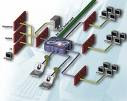-is the physical interconnections of the elements (links,nodes,etc.,)
of a computer network. A local area network (LAN)is one example
of networkthat exhibits both a physical topolgy and a logic topology.
Any given node in the LAND as one or more links to one or more
other nodes in the network and the mapping of this links and nodes
in a graph results in a geometrical shape that may be used to describe
the physical topologyof the network. Likewise, the mapping of the
dataflows between the nodes in the network determines the logic
tropology of the network. The physical and logic tropologies may
or may not be identical in any particular network.
-Any particular network topology is determined only by the graphical
mapping of the configuration of physical and/or logic connections
between nodes. The study of Network Topology uses of graph theory.
Distances between nodes physical interconnections, transmission rates,
and/or signal types may differ in two networks and yet thier topologies
may be identical.
of a computer network. A local area network (LAN)is one example
of networkthat exhibits both a physical topolgy and a logic topology.
Any given node in the LAND as one or more links to one or more
other nodes in the network and the mapping of this links and nodes
in a graph results in a geometrical shape that may be used to describe
the physical topologyof the network. Likewise, the mapping of the
dataflows between the nodes in the network determines the logic
tropology of the network. The physical and logic tropologies may
or may not be identical in any particular network.
-Any particular network topology is determined only by the graphical
mapping of the configuration of physical and/or logic connections
between nodes. The study of Network Topology uses of graph theory.
Distances between nodes physical interconnections, transmission rates,
and/or signal types may differ in two networks and yet thier topologies
may be identical.































